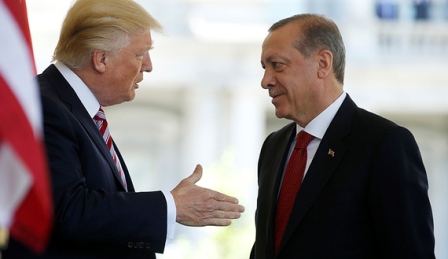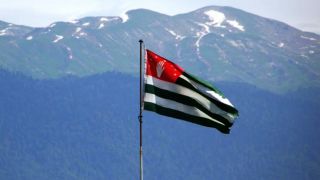The Turkish president’s May 16 visit to the United States has received quite a controversial response. Some experts claim that it marked a rapprochement on some issues. Particularly, the Americans have confirmed their commitment to help the Turks to fight the Kurdistan Workers’ Party (PKK), which both sides regard as a terrorist organization. But the general opinion is that Recep Tayyip Erdogan has left the United States emptyhanded.
His attempt to convince the U.S. Administration to reduce support for the Kurdish self-defenders in Syria has failed. Once again, he was informed that for the Americans, PKK and Syrian-based People’s Protection Units (YPG) are two different things. The latter are successfully fighting ISIL and are already close to its capital, Raqqa. So, the Americans can in no way list them as a terrorist organization.
Erdogan was well aware that it would be hard to convince Trump to change his mind. A week before, on May 9, the Pentagon declared plans to give more arms to the Arab-Kurdish Syrian Democratic Forces (SFD), where YPG has a big role, and ignored all of Turkey’s urges to revise them.
Erdogan failed even there where he was not expected to fail. His urge to extradite Islamic preacher Fethullah Gulen (the man whom the Turkish President blames for the last year’s coup) faced a “counterstrike”: Trump urged him to set free Andrew Brunson, a Protestant pastor, arrested in Turkey last autumn. After 20 years of service in the Turkish city of Izmir, Brunson was caught on suspicion of activities “threatening Turkey’s national security.” The Turks first planned to deport him but later decided to put him into jail – perhaps, in hope to exchange him for Gulen.
But Donald Trump’s urge was all but readiness to exchange the prisoners. He is all but ready to exchange a Turkish “general” for an American “private.” Gulen is much too influential for being bartered for an unknown pastor from Izmir. In any case, it was a message that it would be hard if possible for Erdogan to get Gulen.
The best proof of Erdogan’s fiasco in Washington was that his personal talks with Trump lasted for just 23 minutes. All the previous meetings were no shorter than 40 minutes. Even more, the subsequent meeting of delegations lasted for just two hours. So, we see that the “haughty Ottoman” was not welcome in the White House. And he did not look as haughty as he generally is – he was more like a fish out of water…

“Talking” snapshot emphasizing the plot of Erdogan’s visit: Trump is giving his hand to Erdogan and looking straight into his eyes, while the whole figure and look of the Turkish leader showing his confusion. Photo: Reuters
But it would be counterproductive for the Americans to send the Turkish president back emptyhanded. So, they decided to toss him a bone, more specifically, they offered him three benefits.
In the first two cases, Washington will provide its NATO ally with more intelligence information on “Kurdish terrorists” in Iraq and more arms for fighting them. Middle East sources report that the Americans will give the Turks MQ-1 Predators, S-70 Sikorskys and BLU-109s.
The Turks expected that weaponry since the times of George Bush Jr. and now that Trump is eager to get more control of the Middle East’s arms market, they have higher chances to get what they want. This topic has been negotiated since the mid-2000s and now the situation seems to be quite beneficial.
But this is not enough for Erdogan. He wants one more benefit - compensation for YPG’s success in Syria. The falls of Raqqa and Mosul are inevitable.
Together with SDF, YPG have forced ISIL out of Tabqa just 50 km west of Raqqa and are planning to undertake a decisive attack on the “Caliphate” in early June. The Turks have failed to get into the Euphrates Rage operation, nor have they succeeded in convincing the Americans to reduce the Kurdish representation in SDF or to involve special purpose forces from friendly third states, like Saudi Arabia and its Gulf allies. Erdogan sees that the Syrian Kurds are on the rise and may very soon form a Syrian Kurdistan along Turkey’s southeast border. So, he wants compensation in the form of a military campaign against PKK “terrorists” in the Iraqi town of Sinjar.
After the Turks’ last massive air attacks on PKK, the Kurdish forces moved from Qandil to Sinjar, very close to the Syrian border. The Turks cannot let them take roots in Nineveh Province but they won’t dare to attack Sinjar without the Americans’ consent.
During his visit to Washington, Erdogan mentioned this problem. But Trump gave him no specific answer and took time for consideration. Under current circumstances, this is more like no than yes. But Erdogan is persistent and shortly after his return from Washington, he sent more forces to the Syrian and Iraqi borders.
On May 20, Anadolu quoted military sources as saying that Turkey is committed to rebuff any attacks by PKK’s “terrorist organizations” (they first of all mean YPG and their potential allies in Sinjar). In this context, Anadolu remembered the statement made by Erdogan during his joint press conference with Trump: the Turkish President said that should YPG try to attack Turkey, the latter would defend itself and would not wait for third states’ approval.
The Turks have made all preparations for possible surges into neighboring states. They have deployed troops, opened logistics centers on their borders with Syria and Iraq and are monitoring the PKK- and YPG-controlled territories round-the-clock. Their watch stations are located in the province of Hatay (near the Kurdish enclave of Afrin in the northwest of Syria), Sanliurfa (near Tell Abyad in Raqqa province), Mardin (near Qamishli in Al-Hasakah Province) and also on the border with Iraq.
Many analysts note that for a long time already, U.S.-Turkish relations have been in crisis. Trump’s election has not changed anything. Trump has lots of other problems and priorities. And his last visit to Saudi Arabia has proved this.
For the United States, Turkey has always been a source of problems rather than a solution to them. The Turks have been regarded as such since 2003, when Erdogan first came into power. And their last moves towards Russia and Iran have confirmed this. With Saudi Arabia, things are much clearer: the Saudis oppose Iran and are ready to spend as much as needed for restraining it. In contrast, Erdogan has nothing to offer to the Americans.
So, they will continue waving him off. After just a 23-minute talk with Erdogan, Trump enjoyed a two-day royal reception in Saudi Arabia. And that was perhaps the best way to show Turkey’s place in the White House’s plans for the next four years.
EADaily’s Middle East Bureau

 "In fact, American soldiers were killed in Ukraine" — conspiracy theory in Lithuania
"In fact, American soldiers were killed in Ukraine" — conspiracy theory in Lithuania NYT told about the details of the death of American soldiers during exercises in Lithuania
NYT told about the details of the death of American soldiers during exercises in Lithuania "Bad April Fool's joke": Germans are furious about Berbok's visit to Ukraine
"Bad April Fool's joke": Germans are furious about Berbok's visit to Ukraine "And no one will make a sound" — the European Parliament supported the removal of immunity from the deputy of the "AdG"
"And no one will make a sound" — the European Parliament supported the removal of immunity from the deputy of the "AdG" "Because of the impasse between Trump and Putin": Berbok unexpectedly arrived in Kiev
"Because of the impasse between Trump and Putin": Berbok unexpectedly arrived in Kiev In Thailand, a boat with tourists from Russia and Kazakhstan
In Thailand, a boat with tourists from Russia and Kazakhstan